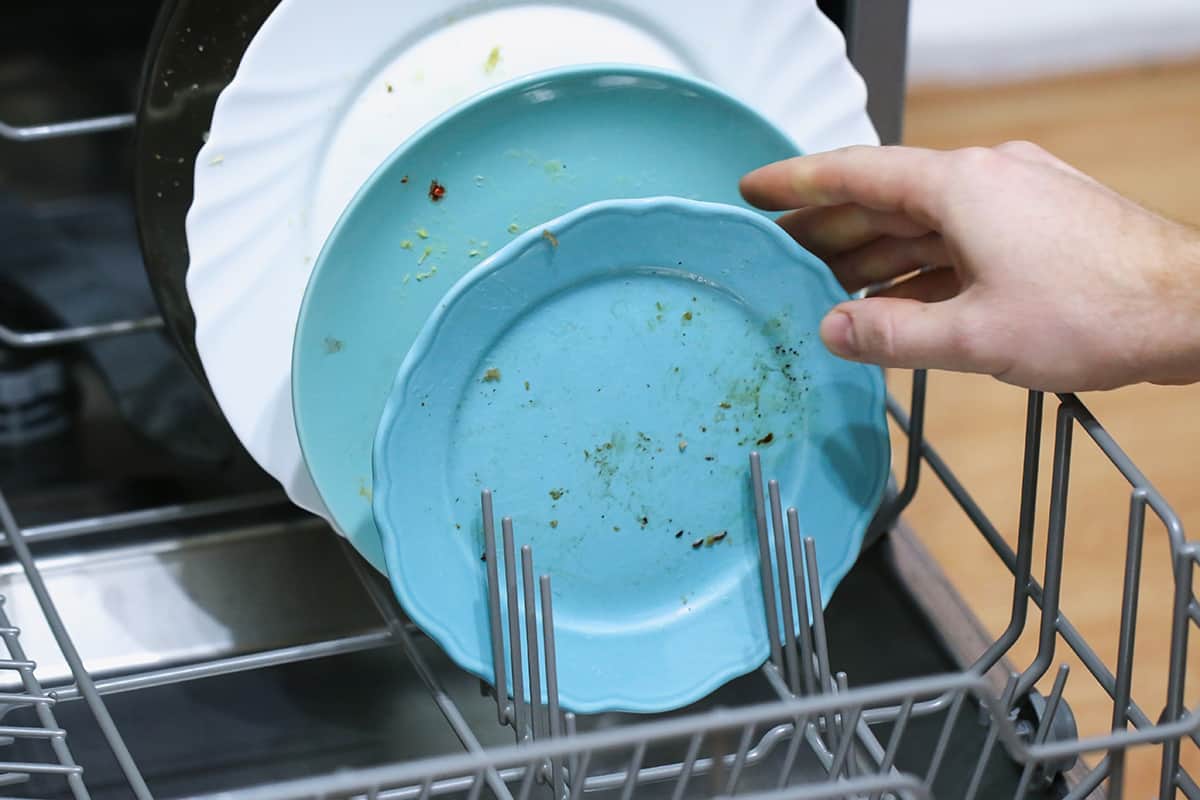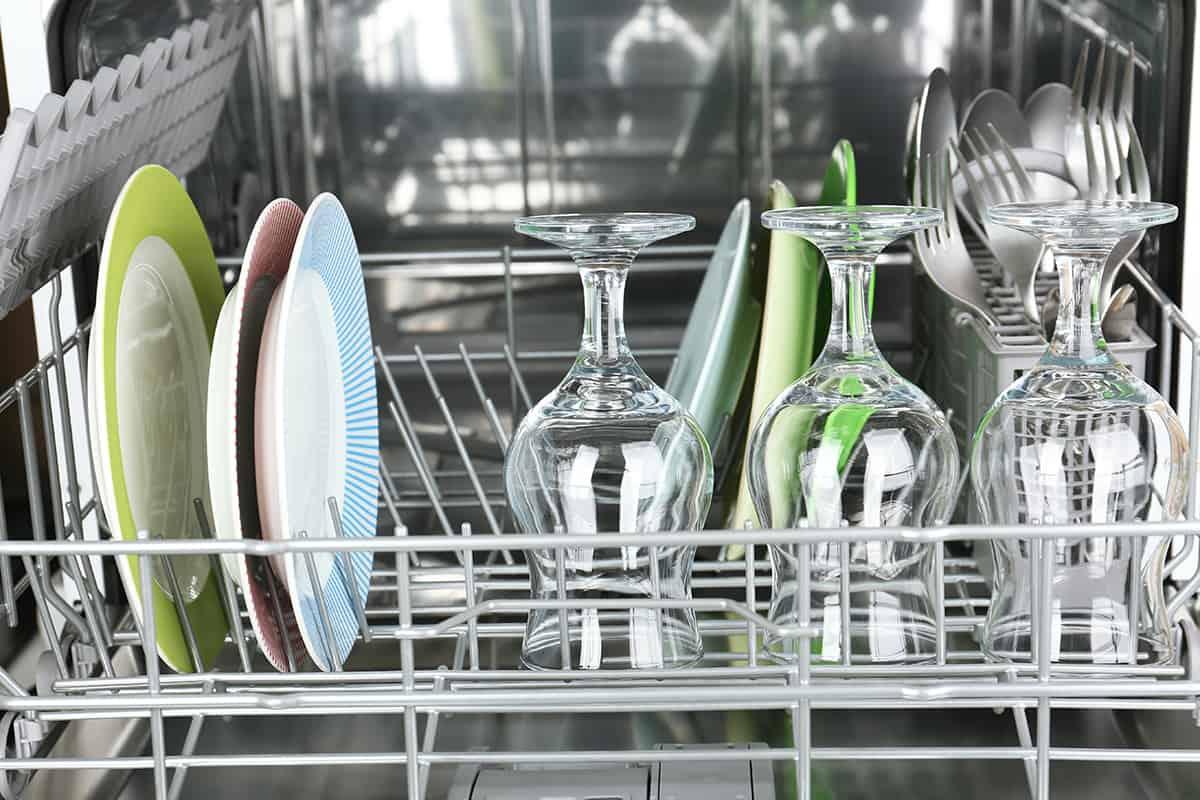A dishwasher is supposed to make life easier by automating the more annoying chore on the planet. However, before you stick anything into your dishwasher, you first need to make sure that it’s safe to wash in a dishwasher. So, is plastic, a common material used for packaging food, considered dishwasher-safe?
It’s fine to wash plastic in a dishwasher. Just make sure you avoid using high-heat wash cycles, such as Sanitize, which can cause plastic containers to melt.
In this guide, I’ll explain how you can safely wash plastic in a dishwasher and what you need to do in order to remove melted plastic from your dishwasher.
Can You Put Plastic in a Dishwasher?
Imagine just having a Thanksgiving feast and having to deal with a mountain of dirty dishes and cookware. It’s not a pretty thought, is it? Luckily for you, you can outsource this highly annoying but necessary chore to your dishwasher. And if you don’t have one, it’s about time you considered getting one!
But the last thing people want to do is figure out whether a specific material is dishwasher-safe. This is mostly a problem for those who use plastic cutlery and containers since, as we all know, plastic melts at pretty low temperatures (100°C or 212°F).
Despite plastic’s relatively low melting point, it’s generally considered safe to wash in a dishwasher. This is especially true if the plastic container sports a dishwasher-safe label, but even without one, you can get by with washing it in the kitchen appliance.
Precautions for Washing Plastic in a Dishwasher

With all that said, there are a few things you should do to ensure your plastic doesn’t deteriorate in your dishwasher.
1. Do not activate a super-hot washing program
As previously stated, most plastics will melt at around the boiling temperature of the water. Even a few degrees under that can be catastrophic to plastic if you leave it exposed to that amount of heat for too long.
To prevent your plastic containers from becoming toast, you should deactivate any add-on wash program that uses heated water above 150°F. This includes but is not limited to the Sanitize program, which usually reaches 160°F.
2. Keep plastic materials away from the heating element
The heating element is the metal coil found on the base of a dishwasher’s tub. Its main job is to heat up the water that enters the dishwasher. It goes without saying that the heating element can get pretty hot—much hotter than necessary to melt plastic.
So, when loading your dishwasher, make sure you place all plastic place settings, cutlery, and containers as far away from the heating element as possible. This usually means loading the top dishrack, but you can get by with loading the bottom dishrack, as long as you’re sure the load won’t wiggle around.
3. Use less detergent than necessary
There’s no telling how your plastic containers will react with chemical-based dishwasher detergent. Best-case scenario, the detergent will wash your plastic dishes without leaving even a scratch. Worst-case scenario, you’re looking at discoloration or even large holes punched into the sides of your plastic dishes.
To prevent any of these things from happening, consider using about 75% the amount of dishwasher detergent that you normally use. However, this can also mean leaving the rest of your dishes unwashed thoroughly.
How to Remove Melted Plastic from Dishwasher
No matter how careful you are in washing plastic in a dishwasher, the risk of melted plastic will always be present. While melted plastic might not sound like a big deal, it can be pretty devastating to a dishwasher. At the very least, you’ll have to deal with the foul odors of melted plastic perfuming your kitchen.
If your plastic container unfortunately melted in the dishwasher, here’s what you need to do:
- Turn off the dishwasher and unplug it from its power source. Hardwired dishwashers will need to be unpowered by flipping the circuit in the breaker box.
- Allow the dishwasher to come down to room temperature.
- Open the dishwasher and unload the dishracks and cutlery basket.
- Pull out the bottom dishrack.
- Inspect the coils for melted plastic.
- Fill a sandwich bag with ice cubes and shut the bag.
- Place the ice-filled bag on the melted plastic for 30 to 60 seconds or until it hardens.
- Use a toothpick, a bamboo skewer, or your fingernail to carefully pry the plastic away from the heating coil. Remove as much of the plastic as possible.
- Soak a clean rag with acetone-based nail polish.
- Place the rag on the remaining bits of melted plastic for 5 to 10 minutes. Do not pour the nail polish directly onto the heating coil.
- Scrub the melted plastic with the nail polish rag until the plastic is gone.
- Soak another rag with fresh, clean water and wipe down the heating coil to remove the nail polish.
- Wash the coils with soap water and rinse it with fresh water.
I agree that the procedure explained above is time-consuming, but it’s necessary if you want to get rid of all the melted plastic from your dishwasher coils.
Best Solution for Washing Plastic Dishes

As you can infer from the previous sections, plastic is quite delicate and needs to be treated as such. While washing plastic dishes in a dishwasher is by far the easiest solution, it may not be the best, especially if you collect expensive Tupperware containers.
So, instead of popping your plastic containers in a dishwasher, I suggest washing all plastics by hand. You’ll have more control over water temperature, the dishes’ exposure to heat, and the aggressiveness of the washing experience.
How to Remove Stains from Plastic
Stained plastic is something many of us learn to live with, but it doesn’t have to be that way. Permanent stains are caused by food particles seeping into the plastic, which is usually the result of reheating leftovers. If your Tupperware is coated in a thin film of last year’s spaghetti dinner, here’s what you can do to get rid of the stain once and for all.
- Mix 1 tablespoon of regular chlorine bleach with 1 cup of water. Make as much of the cleaning solution as necessary.
- Pour the cleaning solution into the plastic container until it reaches the top of the stain.
- Let the cleaning solution sit inside the plastic container for 30 to 60 minutes.
- Empty the plastic container.
- Fill the plastic container with water and dish soap, and vigorously scrub the inside of the plastic container with the rough side of a sponge.
- Rinse and dry the plastic container.
If you don’t feel like adding bleach to your plastic food containers, you can try replacing the bleach solution with a 1:1 mix of water and distilled white vinegar. However, you will need to soak your plastic container in the cleaning solution overnight or longer to loosen the stain.
How to Remove Old Food Smells from Plastic
Another thing you may have to deal with is the leftover odors of yesterday’s dinner in your Tupperware. Here’s what you need to do to get rid of the smell:
- Create a cleaning paste by mixing 4 parts baking soda with 1 part water. Make as much as necessary.
- Smear the cleaning paste all over the inside walls of your plastic container.
- Leave the paste for 30 to 60 minutes.
- Rinse the plastic container and wash it with dish soap and water.
- Rinse the plastic container and allow it to dry.
If this procedure doesn’t get rid of pungent garlicky smells, it might be time to bid your plastic container adieu.






